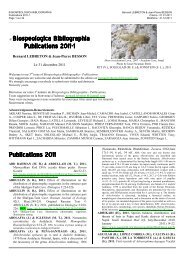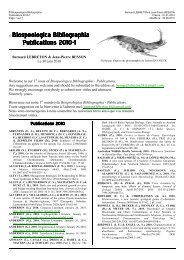Biospeologica Bibliographia Publications 2010-2
Biospeologica Bibliographia Publications 2010-2
Biospeologica Bibliographia Publications 2010-2
You also want an ePaper? Increase the reach of your titles
YUMPU automatically turns print PDFs into web optimized ePapers that Google loves.
© <strong>Biospeologica</strong> <strong>Bibliographia</strong><br />
<strong>Publications</strong> <strong>2010</strong>-1<br />
Page 46 sur 116<br />
and was likely to have been cavicolous and/or straminicolous; (2) strict<br />
troglobitism evolved twice within Amphiacustina, once in the lineage<br />
leading to Noctivox and again in the clade comprising Mayagryllus,<br />
Arachnopsita, Longuripes, and Prolonguripes; and (3) Prolonguripes is<br />
secondarily epigean, having reverted to life above ground. The<br />
occurrence of Araneagryllus gen. nov. in amber indicates that it was not<br />
troglobitic, but was instead more likely to have been straminicolous,<br />
living on the ground and foraging amongst leaf litter. Araneagryllus gen.<br />
nov. possesses a number of characters that are usually considered to be<br />
adaptive to a troglobitic life history, suggesting that many so-called<br />
troglobiomorphies are not adaptations to life in caves, but are instead<br />
likely to have been exaptive. KW: Amphiacustae, Dominican amber,<br />
Ensifera, Neotropics.<br />
HENDERSON (K.), <strong>2010</strong>. The 6 th ISCA Congress <strong>2010</strong>. Or<br />
how to find happiness in the changing world of caves.<br />
AKMA Journal 81(December):15 p.<br />
HERMOSÍN (B.), NOVÁKOVÁ (A.), JURADO (V.),<br />
LÁIZ (L.), PORCA (E.), ROGELIO (M. A.),<br />
SÁNCHEZ-MORAL (S.) & SÁIZ-JIMÉNEZ (C.),<br />
<strong>2010</strong>. Observatorio microbiológico de cuevas: evaluación<br />
y control de comunidades fúngicas en cuevas sometidas al<br />
impacto de actividades turísticas [Caves microbial<br />
observatory: assessment and control of fungal<br />
communities in show caves]:513-520. In: DURÁN (J. J.)<br />
& CARRASCO (F.), Cuevas: Patrimonio, Naturaleza,<br />
Cultura y Turismo, Madrid, Asociación de Cuevas<br />
Turísticas Españolas, DURÁN (J. J.) & CARRASCO (F.),<br />
Eds. RES: En la última década se está asistiendo a una progresiva<br />
colonización de cuevas visitables por microorganismos. Así, las cuevas<br />
de Lascaux, Montignac, Francia, y de Castañar de Ibor, Cáceres,<br />
sufrieron brotes de Fusarium solani, hongo que ha sido encontrado<br />
también en la cueva de Doña Trinidad, Ardales, Málaga. En este trabajo<br />
se plantean las bases para la creación de un Observatorio Microbiológico<br />
de Cuevas, desde donde se pueda controlar los hongos presentes en el<br />
ecosistema, y detectar a tiempo aquellos brotes que pudieran<br />
comprometer la integridad de la cueva y sus pinturas rupestres, en el caso<br />
que las tuviera. Al mismo tiempo, se pretende estudiar las relaciones<br />
entre la comunidad fúngica y los habitantes de las cuevas (insectos,<br />
roedores, etc.), ya que muchos de los hongos presentes son parásitos de<br />
otros organismos y los utilizan para su entrada y dispersión en la cueva.<br />
Para el desarrollo de este estudio es fundamental el control del aire de la<br />
cueva, así como la utilización de técnicas moleculares como la<br />
amplificación de secuencias de los genes de ARN ribosómico 18S e ITS<br />
con el fin de identificar los miembros de las comunidades fúngicas. La<br />
distribución espacial y temporal de los componentes de la comunidad<br />
fúngica se llevará a cabo mediante muestreos en distintas estaciones del<br />
año en las diferentes salas de las cuevas. Al mismo tiempo se determinará<br />
la presencia de hongos metabolicamente activos en distintos nichos. El<br />
conocimiento de los procesos de dispersión de esporas y su modelización<br />
teniendo en cuenta las corrientes de aire y los gradientes de temperatura,<br />
la eventual colonización de distintos materiales por comunidades<br />
microbianas, las características tróficas de estas comunidades y las<br />
relaciones entre los distintos habitantes de la cueva deben permitir el<br />
diseño de una estrategia de control que garantice su conservación. PC:<br />
Cadena trófica, colémbolos, cuevas, hongos, roedores. ABS: The last<br />
decade has seen a progressive colonisation of visitable caves by<br />
microorganisms. The caves of Lascaux, Montignac, France, and of<br />
Castañar de Ibor, Cáceres, have suffered outbreaks of Fusarium solani, a<br />
fungus that has also been found in Doña Trinidad Cave, Ardales, Málaga.<br />
This work sets out the bases for the creation of a Cave Microbiological<br />
Observatory for controlling the fungi present in the ecosystem and the<br />
timely detection of outbreaks that could compromise the integrity of the<br />
cave and any cave paintings present. At the same time, it is intended to<br />
study the relationships between the fungal community and cave<br />
inhabitants (insects, rodents, etc.), as many of the fungi present are<br />
parasites, and use the inhabitants to enter the cave and disperse in it. The<br />
execution of this study entails monitoring the air of the cave, and the use<br />
of molecular techniques such as the amplification of gene sequences of<br />
18S and ITS ribosomal RNA to identify the members of the fungal<br />
communities. The spatial and temporal distribution of the components of<br />
the fungal community will be examined by samplings in different seasons<br />
of the year in the various halls of the caves. The presence of<br />
metabolically active fungi in various niches of the caves will be tested.<br />
Knowing the processes of spore dispersion and modelling it taking into<br />
Bernard LEBRETON & Jean-Pierre BESSON<br />
Créé le : 01.01.<strong>2010</strong><br />
Modifié le : 30.06.<strong>2010</strong><br />
account air currents and temperature gradients, the eventual colonisation<br />
of different materials by microbial communities, the trophic nature of the<br />
latter, and the relationships between the different inhabitants of the cave,<br />
should enable the design of a control strategy to guarantee its<br />
conservation. KW: Caves, colembola, food chain, fungi, rodents.<br />
HERMOSÍN (B.), NOVÁKOVÁ (A.), JURADO (V.),<br />
LÁIZ (L.), PORCA (E.), ROGERIO (M. A.),<br />
SÁNCHEZ-MORAL (S.) & SÁIZ-JIMÉNEZ (C.),<br />
<strong>2010</strong>. Microbial observatory of Spanish caves: assessing<br />
the origin of fungal outbreaks:101. In: 20 th International<br />
Conference on Subterranean Biology, Postojna, Slovenia,<br />
29 August-3 September <strong>2010</strong>, ICSB <strong>2010</strong> Abstract Book,<br />
edited by: Ajda MOŠKRIČ and Peter TRONTELJ, ISBN<br />
978-961-269-286-5. ABS: The last decade has seen a progressive<br />
colonization of visitable caves by microorganisms. The caves of Lascaux,<br />
Montignac, France, and of Castanar de Ibor, Caceres, have suffered<br />
outbreaks of Fusarium solani, a fungus that has also been found in the air<br />
and sediments of the Dona Trinidad Cave, Ardales, Malaga. This work<br />
sets the bases for the creation of a Cave Microbiological Observatory for<br />
controlling the fungi present in the ecosystem and the timely detection of<br />
outbreaks that could compromise the integrity of the cave and any cave<br />
paintings present. At the same time, it is intended to study the<br />
relationships between the fungal community and cave inhabitants<br />
(insects, rodents, etc.), as many of the fungi present are parasites, and use<br />
the inhabitants to enter the cave and disperse in it. The execution of this<br />
study entails monitoring of the cave air, and the use of molecular<br />
techniques such as the amplification of gene sequences of 18S and ITS<br />
ribosomal RNA to identify the members of the fungal communities.<br />
Knowing the processes of spore dispersion and modelling it taking into<br />
account air currents and temperature gradients, the eventual colonization<br />
of different materials by microbial communities, the trophic nature of the<br />
latter, and the relationships between the different inhabitants of the cave,<br />
should enable the design of a control strategy to guarantee its<br />
conservation. http://www.icsb<strong>2010</strong>.net/<br />
HERSHLER (R.), LIU (H.-P.) & LANG (B. K.), <strong>2010</strong>.<br />
Transfer of Cochliopa texana to Pyrgulopsis<br />
(Hydrobiidae) and description of a third congener from the<br />
lower Pecos River basin. Journal of Molluscan Studies<br />
76(3, August 22):245-256. DOI:<br />
http://dx.doi.org/10.1093/mollus/eyq002. ABS: The Phantom<br />
Cave snail (Cochliopa texana), a little-studied rissooidean gastropod that<br />
is locally endemic within the lower Pecos River basin (Texas) and<br />
currently a candidate for addition to the Federal list of threatened and<br />
endangered species, is redescribed and transferred to the hydrobiid genus<br />
Pyrgulopsis, based on shell and anatomical characters. Specimens from<br />
the type locality (Phantom Lake Spring) and San Solomon Spring are<br />
larger than those from East Sandia Spring and also differ somewhat in<br />
shell shape and shape of the central cusps of the lateral radular teeth.<br />
However genetic (mtCOI, NDI) variation within and among these<br />
geographically proximal (613 km) populations was slight, providing no<br />
basis for the recognition of distinct conservation units of this imperiled<br />
species. We also describe Pyrgulopsis ignota n. sp., which was recently<br />
discovered in a different part of the lower Pecos River basin and initially<br />
confused with the Phantom Cave snail. These two species differ in shell<br />
shape, operculum morphology, and form and glandular ornament of the<br />
penis. They are also strongly differentiated genetically from each other<br />
and from (13) other regional congeners (pairwise sequence divergence<br />
>6.3 for both genes). A Bayesian phylogenetic analysis of the COI and<br />
NDI dataset indicated that these two snails are not closely related and that<br />
P. ignota occupies a basal position relative to other regional congeners.<br />
HIPPA (H.), VILKAMAA (P.) & HELLER (K.), <strong>2010</strong>.<br />
Review of the Holarctic Corynoptera Winnertz, 1867, s.<br />
str. (Diptera, Sciaridae). Zootaxa 2695(December 3):1-<br />
197, 127 pl., 159 réf.<br />
http://www.mapress.com/zootaxa/list/<strong>2010</strong>/2695.html<br />
HITCHCOCK (A.), <strong>2010</strong>. Shale Peak Cave and the<br />
Discovery of a New Species of Cave Cricket. Cape<br />
Peninsula Speleological Society (CPSS) Newsletter<br />
(March):2 p.<br />
HLAVÁČ (P.) & JALŽIĆ (B.), <strong>2010</strong>. Endogean and<br />
cavernicolous Coleoptera of the Balkan. X. Two new





